Branching Out, variations
I took a lace-knitting class at CHT, and found out that it’s not as impossible as I had heretofore believed. We did Old Shale as a learning experience, which didn’t turn me on so much… but it paved the way.
So Susan Lawrence’s Branching Out on Knitty was just the right thing at the right time. Hard enough to make me really learn what I’m doing, easy enough that I didn’t throw it against the wall in despair more than twice, at least after I learned how to set life lines.
I have a bunch of nice fingering-weight alpaca (200 yards / 50 grams) yarn from an Ebay auction that I decided would be nice – it turned out to be a good choice, as it tinked relatively easily and stood up to the constant fiddling that I had to do while learning the pattern. It’s not as soft as I wish it were; it’s got an odd blend of very-soft and slightly-scratchy touch.
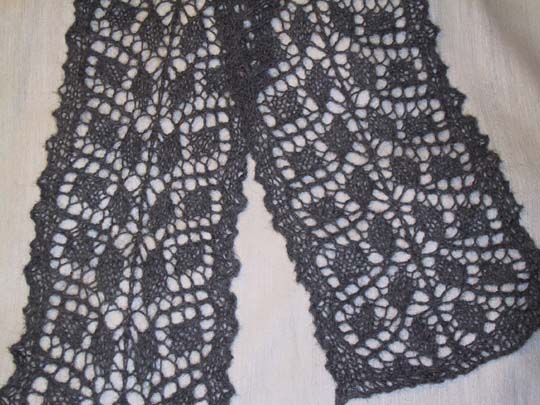
Here’s the finished scarf, mostly laid out. It’s a long rectangle, so it’s tough to take an attractive photo of the whole thing in a single shot.

Here’s a closeup. The alpaca does fuzz out some, but not so much that it obscures the stitching. I used slightly smaller needles than called for in the pattern (6, instead of 8) because the 8’s were giving me a too-holey fabric in a blocked swatch. I like the way it turned out, spacing-wise.
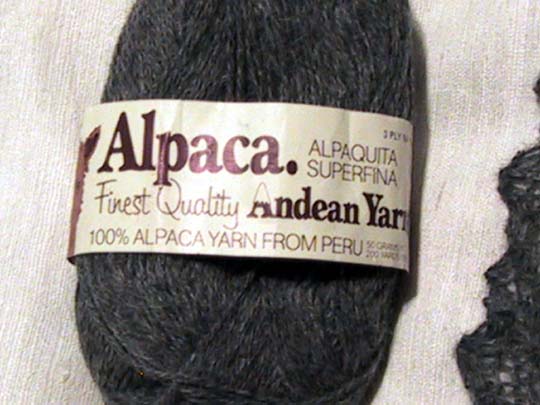
This is the yarn I used. It’s not amazing quality alpaca; I want to do this again with hand-spun alpaca, because I’ve got some good quality stuff, and it’s a lot softer.
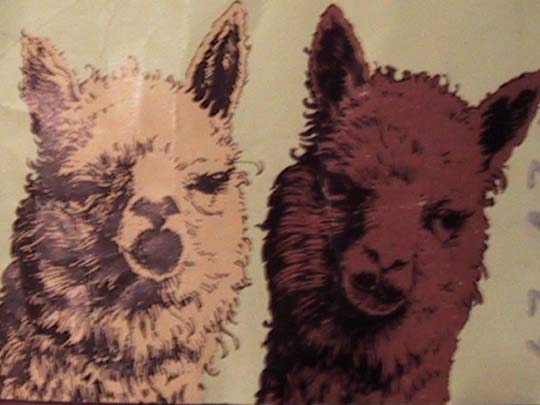
The pictures of alpacas printed on the ball band look like they have waaaaay too much makeup on. They look like alpaca hookers. “Hey, big boy… you’re a big hot camelid STUD… whose daddy are YOU?”
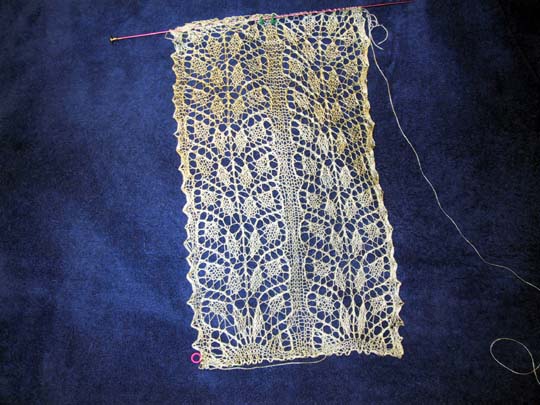
In order to get it to work out wide enough in the silk yarn I wanted to use, I made it two repeats across, with a garter bar between. I like the effect, although I’m not sure if the center bar ought to have some occasional patterning, in a design sense. This is worked in 35d10x2 Tussah organzine from Habu – it’s a reeled Tussah thread about the weight of #10 crochet cotton. It’s on #1 needles. Yes, I blocked it while it’s on the needles, to check how it was going to come out. I have this feeling that it’s against the rules, and I felt naughty while doing it, but it doesn’t seem to have damaged the fabric at all. The needles are aluminum; I would hesitate to try that with wood or steel. The silk responds *beautifully* to blocking.

You can see the color in this one, a little. The silk sheens in the light, so you only see the real color in a part that is turning away from you. I’m not sure whether this will end up dyed a solid green, or left natural tussah color, which is a pretty ecru.
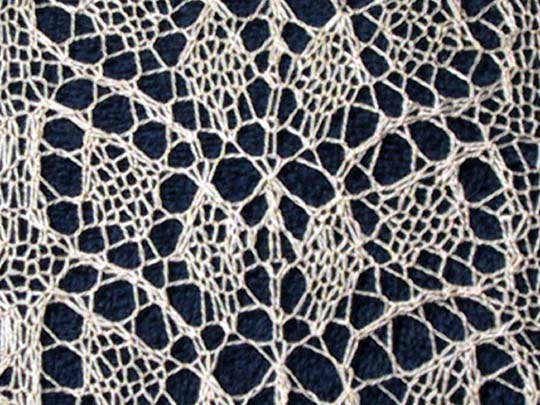
A close-up, where you can see that my tension isn’t as even as it ought to be.
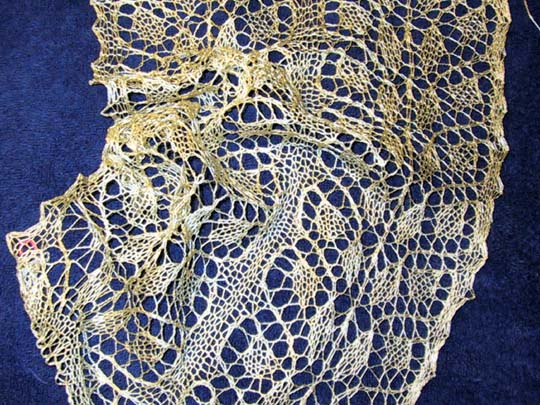
Here, I tried to crumple it a little, to show the sheen of the silk. What it looks like instead, is that the cat yakked on one side. But, if you look at it and kinda squint, and tell yourself “This isn’t cat-barf on the scarf, it’s the luxurious sheen of the reeled silk,” you kinda get it.

How beautiful! I think the garter-bar on the silk one looks fine. It’s a perfect frame for the two sets of pattern, almost like the bar in a window, you know?
I start out thinking I would do horizontal bars at intervals, like four repeats, like window panes… but it didn’t turn out like planned, so I just went with a center divide.
I don’t understand any of the technical stuff- but it’s beautiful. And I vote for dying it green. 🙂
Okay, is there anything you DON’T do?!?
And don’t say windows!!
The silk one is lovely and I actually find the alpaca rather interesting but I nearly snarfed when you said ‘alpaca hookers’..that could have been messy.
Those are great! The one made of silk looks so delicate. I could see it in a museum display!
Wow!
They’re beautiful! And I know — silk, or anything with sufficient silk content, is impossible to photograph because you can’t get the sheen and it comes out looking totally weird.
You should really, really get the out-of-print and hard to find Susanna Lewis “Knitting Lace” book, which is my absolutely top pick and really, really worth it IMHO if you’re going to knit lace. My dad gave me my copy just before he died, as his parting shot in our lifelong fiber back-and-forth, and if it weren’t for that, I’d have continued possibly forever in my “Yeah, yeah, lace knitting, pfeh, no thank you,” stance.
Ouch… a hundred-dollar paperback! I’m sure it’s amazing, but, gosh!
I’ve been told to look for the Walker books and Kinzel’s lace books as well. Any aspect in particular that sets the Lewis book head-and-shoulders above the rest?
As always, your skills and achievements astound me.
Yes, there are several. I’ll start by saying that if I lost my copy and had to replace it, I would pay as much as $200 without blinking. I use it THAT MUCH.
The Lewis book is her study of an old sampler in a museum. The sampler was clearly not a look-pretty one, but was itself a reference work in textile form. The book is well-subtitled as ‘a workshop’ — it IS a workshop.
While the Walker and Kinzel books (which I also have acquired a number of) are good, they do not get into the real nitty-gritty of the structural elements in play. The Lewis book not only does that, but in the charts for the sampler patterns, clearly separates out what is the meat of the pattern, where the elements of it interact, how they interact, what the fudge stitches are, how to figure a lot of that sort of thing, and so forth. It also includes several studies of executing the same essential pattern with variations, so that you can understand how to achieve different results with what’s basically the same pattern. Beyond that, it includes a good section on reading charts in the first place, a section on charting from a finished object, and a section on modifying the lace patterns to put them to work in various applications. Aaaaand it includes machine-knitting info for all the designs. It’s been close to a year since I started working through it and I’d say I’m a quarter of the way into what I can learn from it (after which it’ll be a reference more than a workshop). At this point, however, I can freehand lace off the top of my head and have it come out how I want way more often than not.
*all* of the other lace books that I have are essentially pattern libraries (though there’s also cultural information and some other interesting stuff in the one Orenburg shawl book). The Lewis book, by contrast, is a resource to turn you into a badass lace knitter, and I would even argue that a lot of what’s in it is not really limited to lace, but includes really useful info that can be applied to shaping, bias, and garment construction as well.
I’ve got the book on my email-me-when-it-arrives lists at several places and have yet to manage to buy another copy, and I’m in the market for one on general principle.